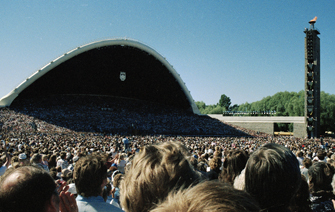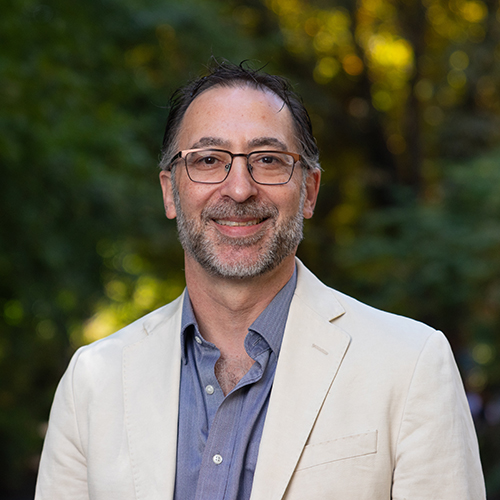Songs are powerful weapons.
When the Soviet Union attacked the newly independent Baltic nations in 1991, Baltic citizens responded by gathering en masse and singing in nonviolent protest. The Soviets eventually backed down.
In his new book The Power of Song, Guntis Šmidchens explores what is often dubbed “the Singing Revolution,” a passive resistance movement that took hold in the Baltic nations of Latvia, Lithuania, and Estonia in the late 1980s and early 1990s.
The unlikelihood of three fledgling nations defeating the Soviet military through song is not lost on Šmidchens, associate professor of Scandinavian studies and Kazickas Family Endowed Professor in Baltic Studies. “The way nonviolent movements work, every case seems impossible,” he says. “This one was no different. But like many others before it, it did work.”

Šmidchens explains that the idea of singing as a form of resistance has a long history in the Baltics, dating back to nineteenth century choirs meeting and performing in defiance of the Tsar. In an 1873 essay titled “The singing Latvian nation,” Latvian poet Auseklis (Mikus Krogzemis) famously wrote, “That nation does not stain steel swords and spears with the precious blood of people. Peace is its stately, proud flag; a shield of songs which repels the spear.”
In the mid-twentieth century, Baltic countries under Soviet rule were denied freedom of speech, but choirs still found ways to rebel through song. Choir festivals, held every five years, would feature songs of loyalty to the Soviet Union, but after the official program the choir would often perform a familiar song—a folk song, for example—that despite neutral content would become a song of resistance, with the enormous audience singing along.

“Just singing non-Soviet songs—they weren’t anti-Soviet—was seen as an act of resistance,” says Šmidchens. “The Soviets quickly recognized such songs as national anthems and would ban them. The people who organized the festivals were sometimes sent to Siberia. So the Singing Revolution, the model for how to organize a resistance, was already there at these festivals.“
Mikhail Gorbachev eased some restrictions on freedom of speech in the Baltics in the late 1980s, including letting choirs choose their songs. Citizens took these freedoms far beyond what Soviet leaders had intended. They stopped singing Soviet songs and began singing songs that were explicitly about independence. At a 1988 Lithuanian choir festival, singers unfurled a pre-Soviet Lithuanian flag on stage; when Soviet officials tried to remove the activists from the stage, other choir members squeezed together to block access.
Patriotic fervor quickly grew. Gorbachev eschewed a violent response, having seen the disastrous results of such a response in China’s Tiananmen Square. Within two years, the Baltic nations held government elections and negotiated independence from the Soviet Union.

The transition was relatively smooth—for a while. Then, in 1991, Soviet anti-independence forces decided to crack down. “When Moscow changed its mind and decided to use violence to overthrow the Baltic governments, the public remained disciplined in its nonviolent response,” says Šmidchens. “The only thing defending the three independent governments was a mass of citizens who believed that they could win in a nonviolent way through song.” Gorbachev, facing the prospect of killing thousands of unarmed citizens, chose to let the Baltic countries go.
Šmidchens has long been fascinated by what happened in the Baltics. In 1998 he served as translator at the Smithsonian Festival, a Washington, DC concert commemorating the tenth anniversary of the Singing Revolution, at which many songs of the resistance were performed. Fifteen years later, Šmidchens’ explores these songs—and many more—in greater depth in his book. “To my surprise, scholars of nonviolence have not been looking at what songs and singing do for nonviolent movements,” he explains. “They haven’t been asking that question.”
The book features 112 songs connected to the Singing Revolution, from hymns to folk songs to rock anthems, all translated by Šmidchens. “I wanted to include another 50 songs, but I had to cut the book down,” he laments. Šmidchens explores the context of each song—both the events at which it was sung and the speeches that surrounded it—and delves into political science theory and music therapy to better understand how songs became powerful tools of protest.

“Singing raises self-esteem and gives people a sense of community,” explains Šmidchens. “It can calm violence in a really threatening situation. In the Baltics, it was a way that each person in those demonstrations got their courage. What they had to build on was something very unique—this 150-year-old choir movement that recognized singing and songs as weapons, as something that could be adapted to a nonviolent movement. And, miraculously, it worked.”
The Power of Song will be available from University of Washington Press in January 2014.
More Stories

Need a break from holiday movies? Try these
For those wanting a break from holiday movies, Cinema & Media Studies faculty and grad students offer suggestions.

The Public Impact of Private Cities
Geography major Edwin Bai has researched private cities, developed by individuals and corporations, that "take the libertarian idea of low government regulation to the maximum."

The Curious Journey of Chinese Characters
Several Asian countries adapted the Chinese writing system—the oldest writing system still in use—for their own languages. In a new book, Professor Zev Handel shares how that happened.